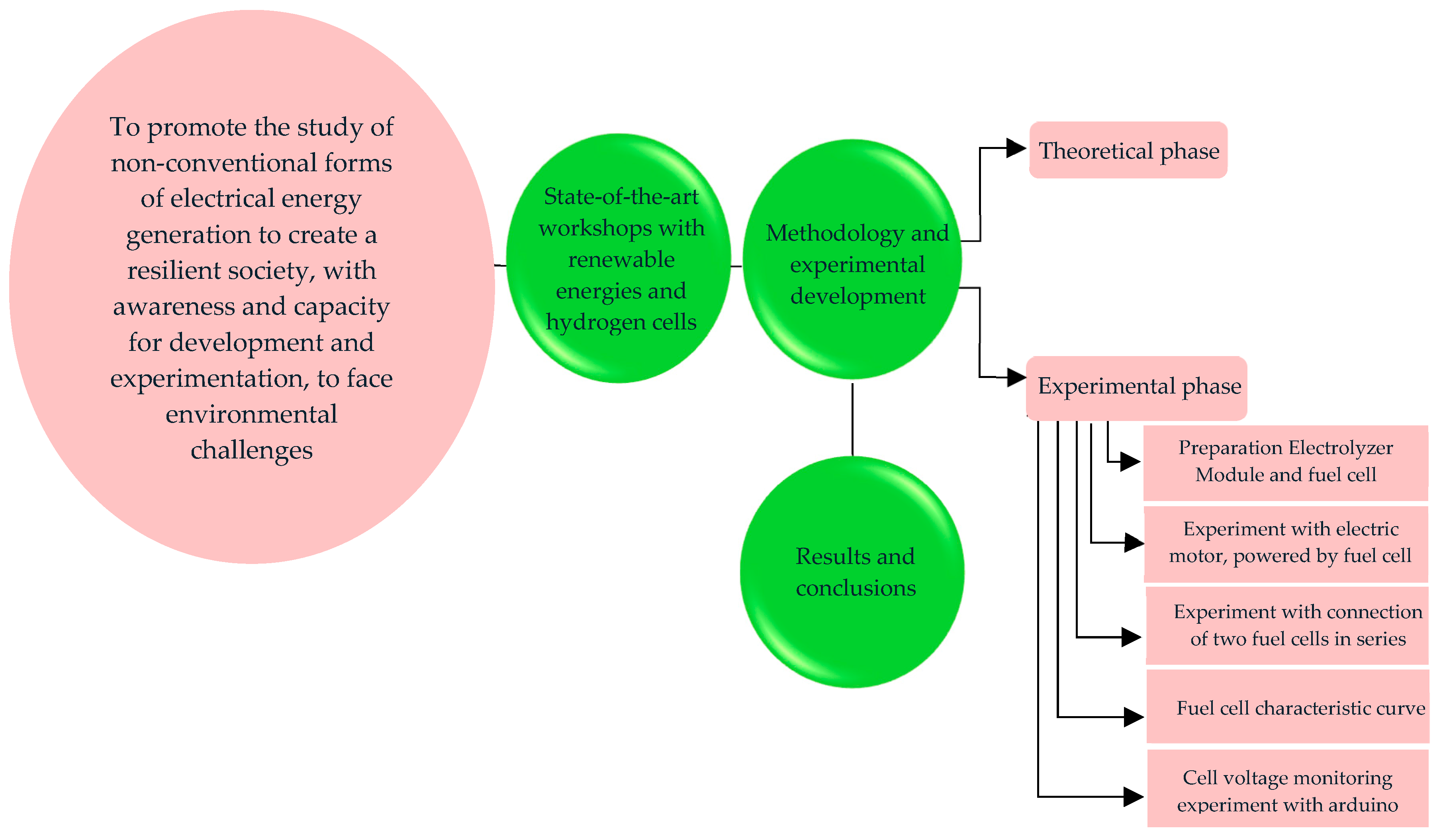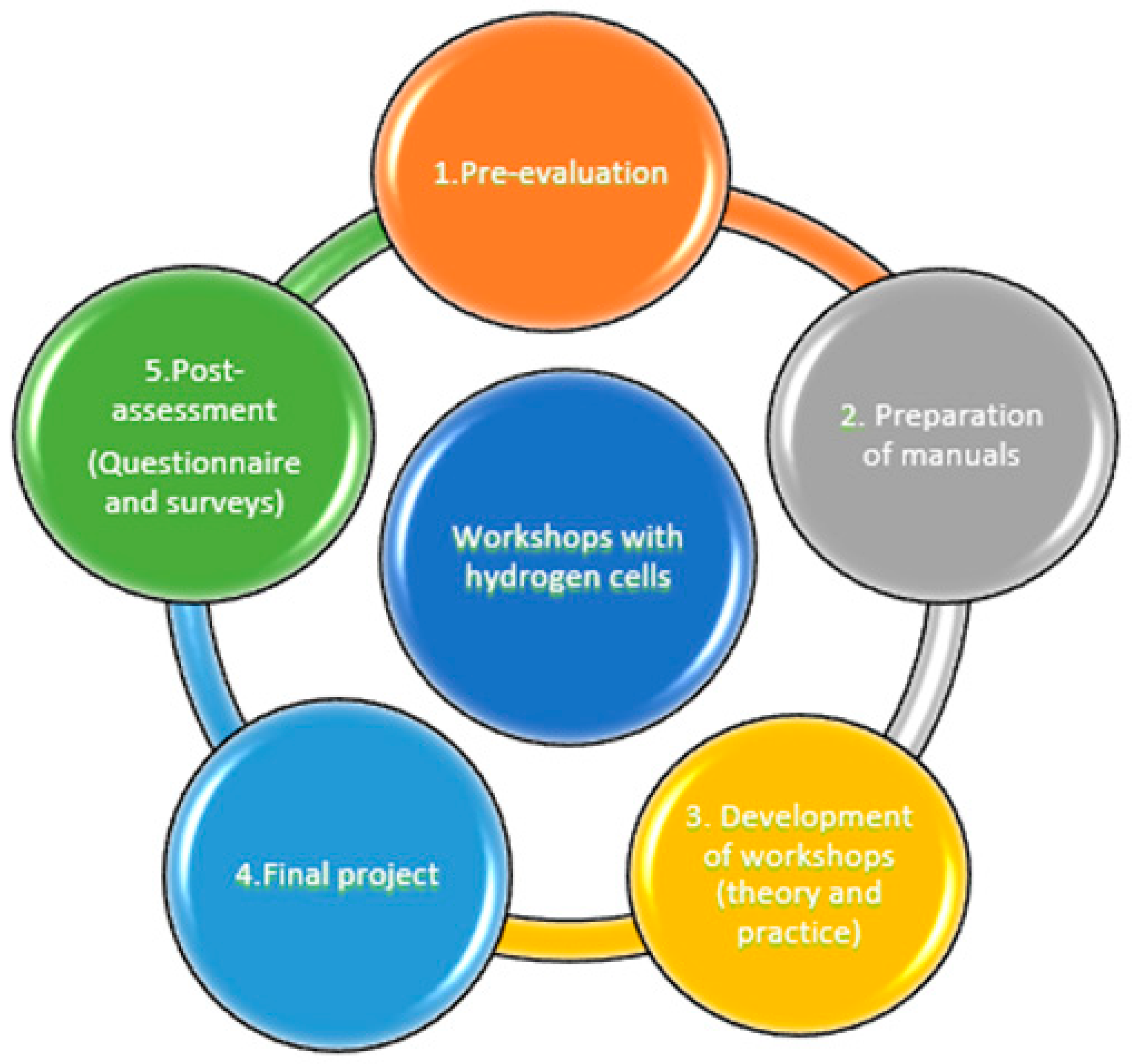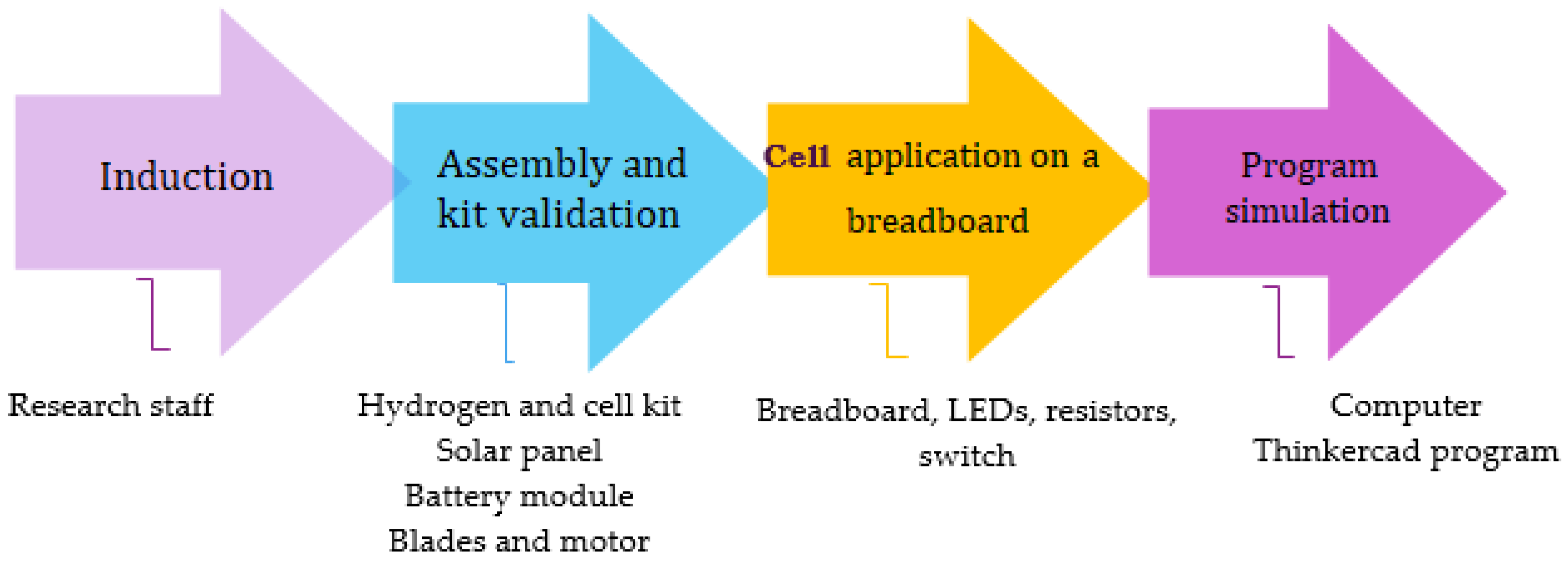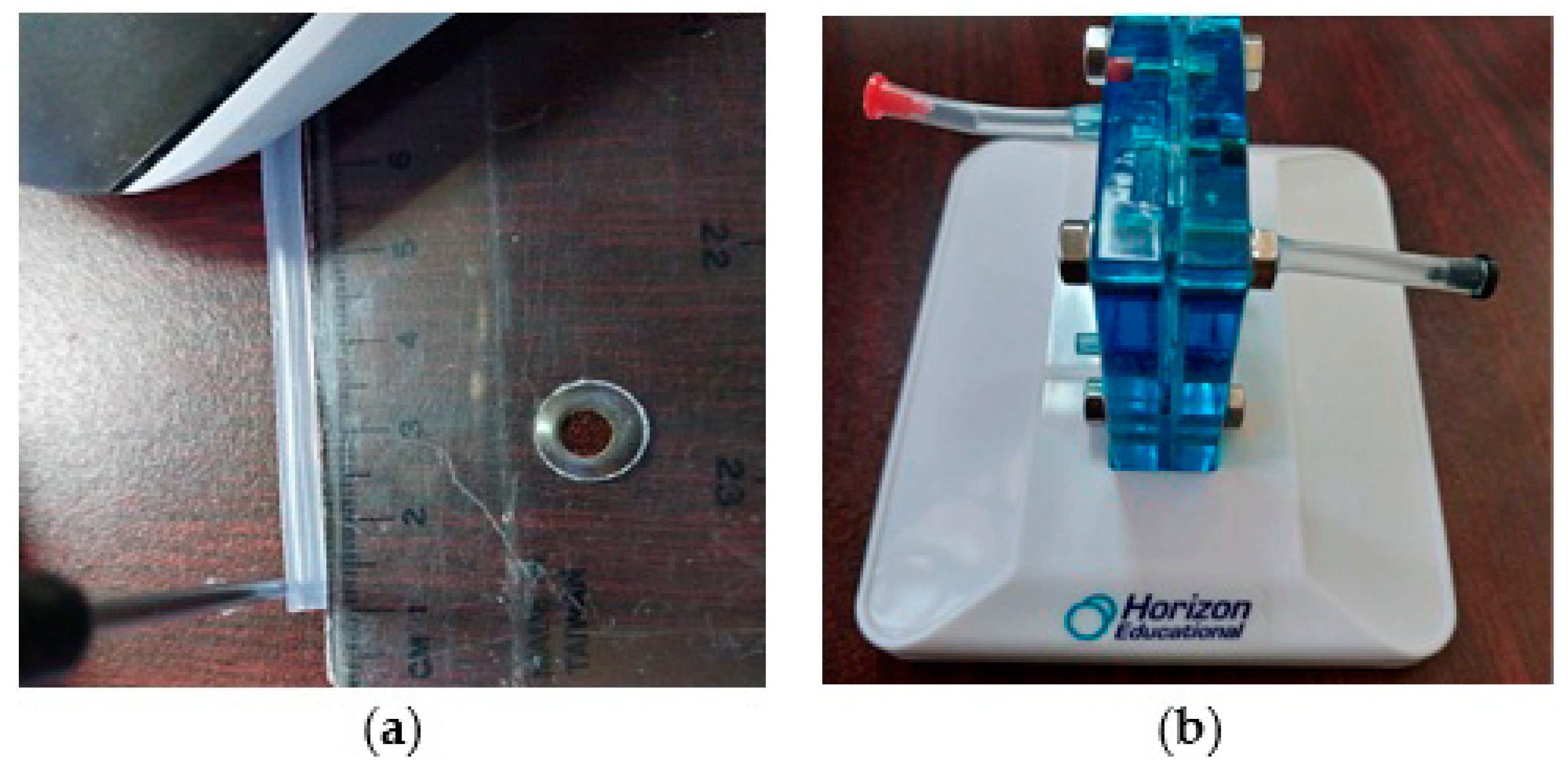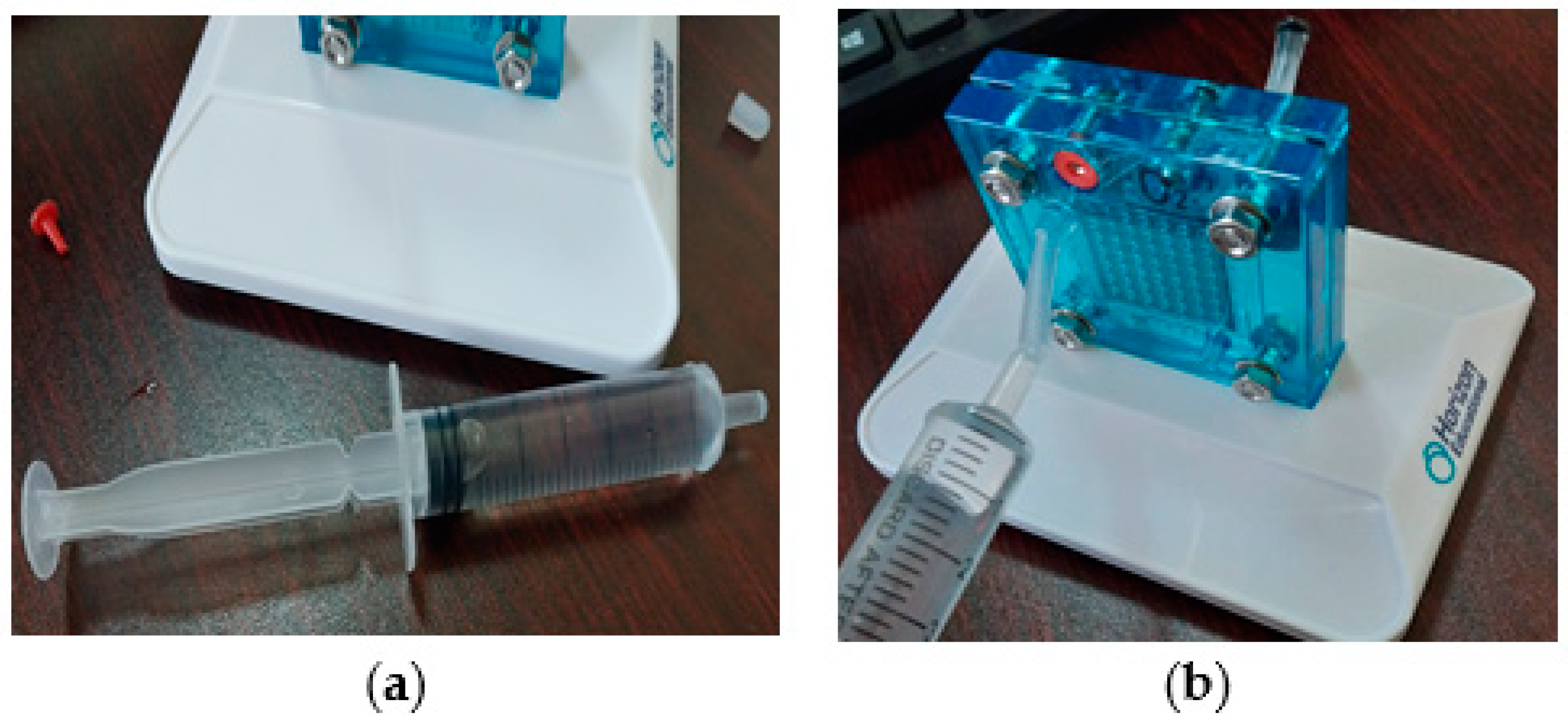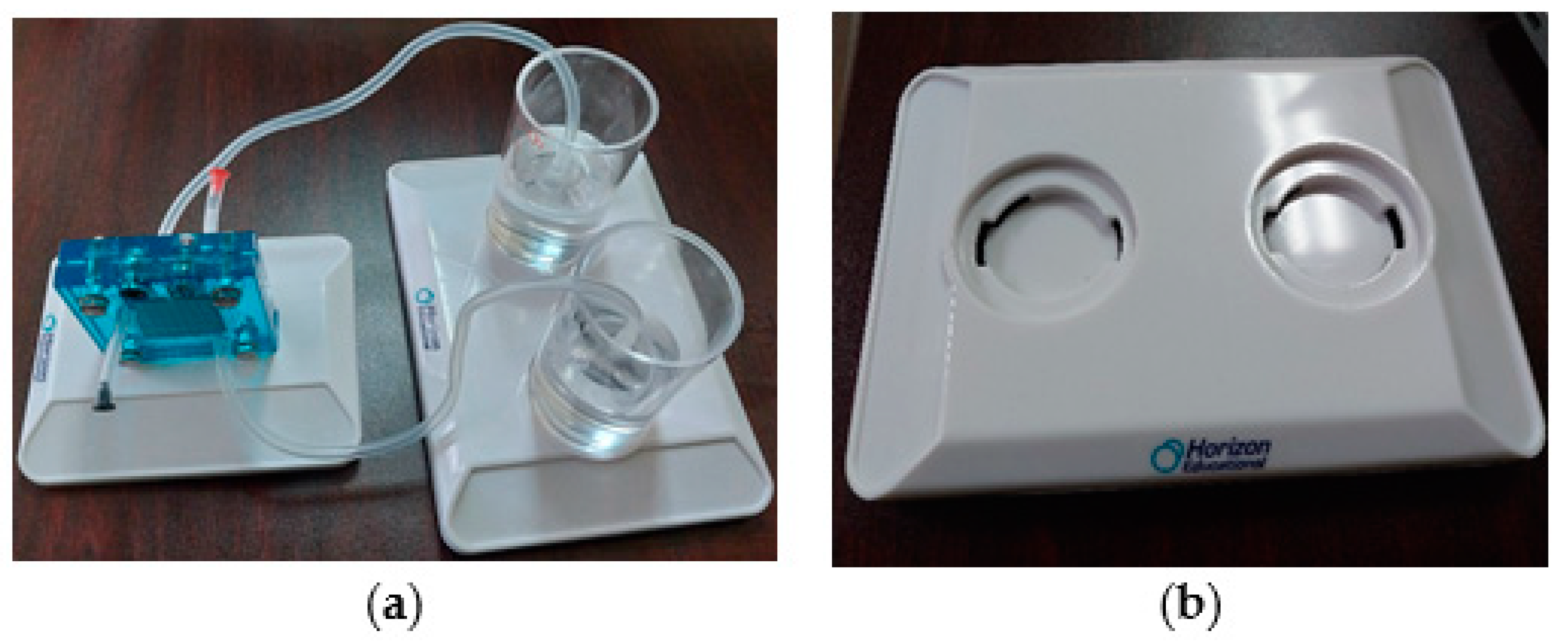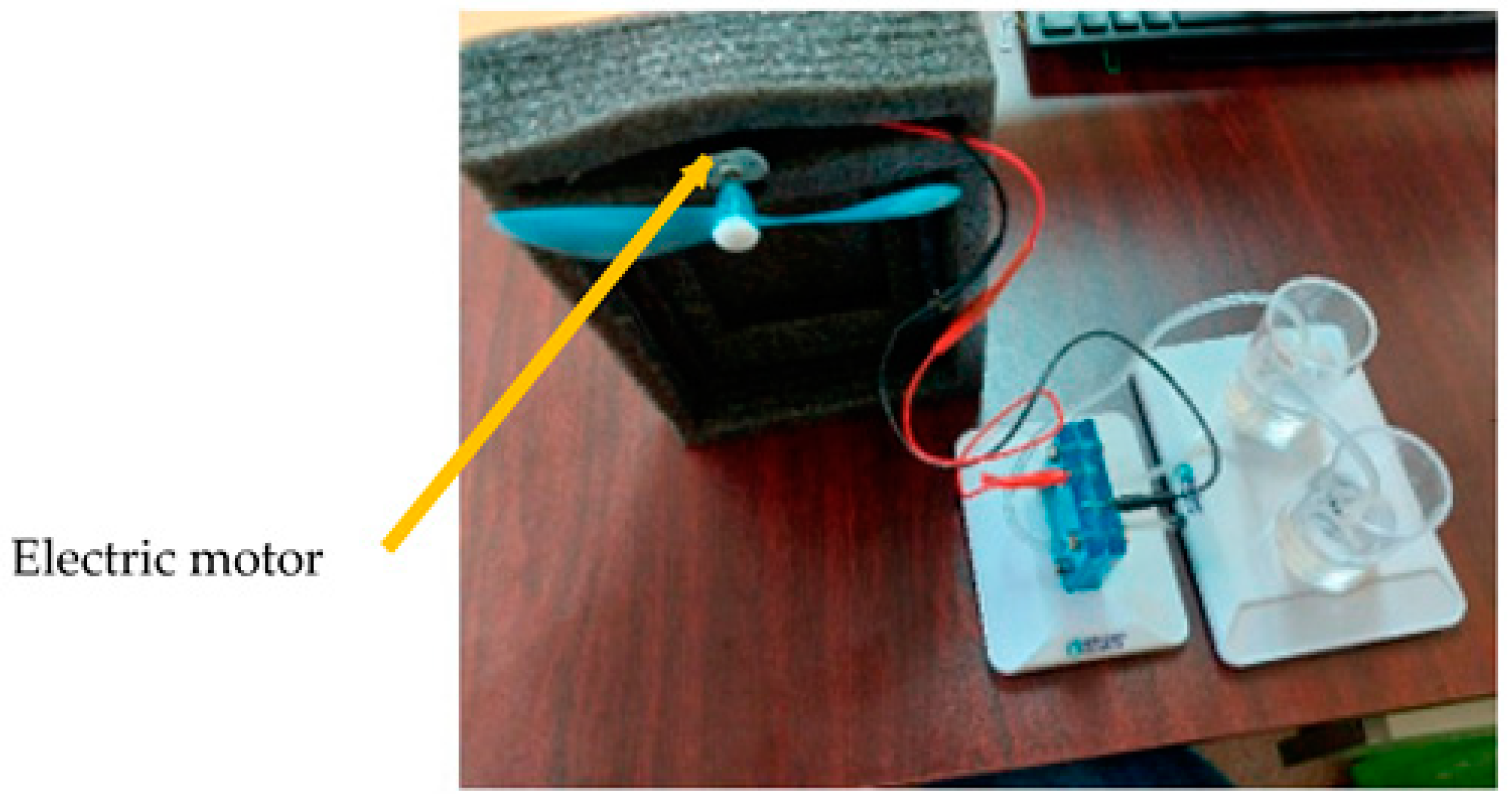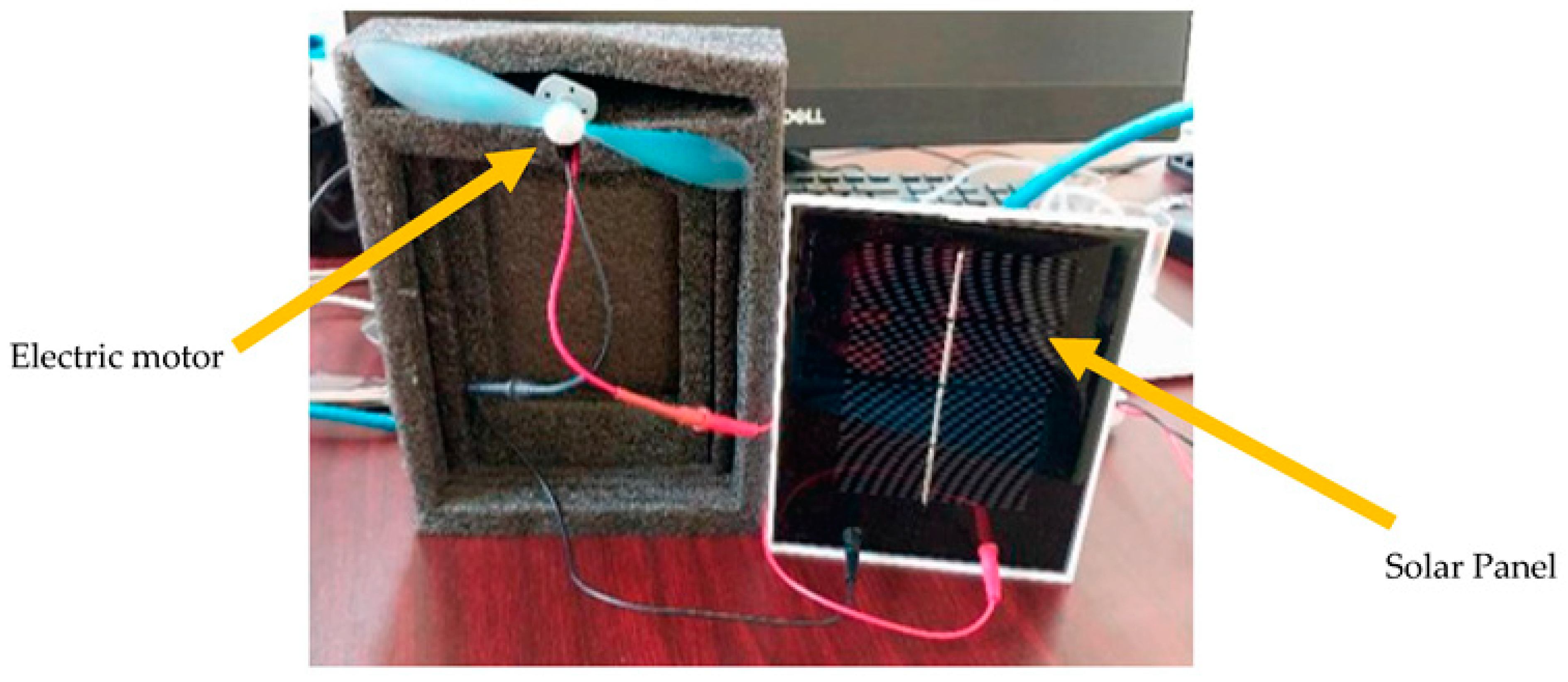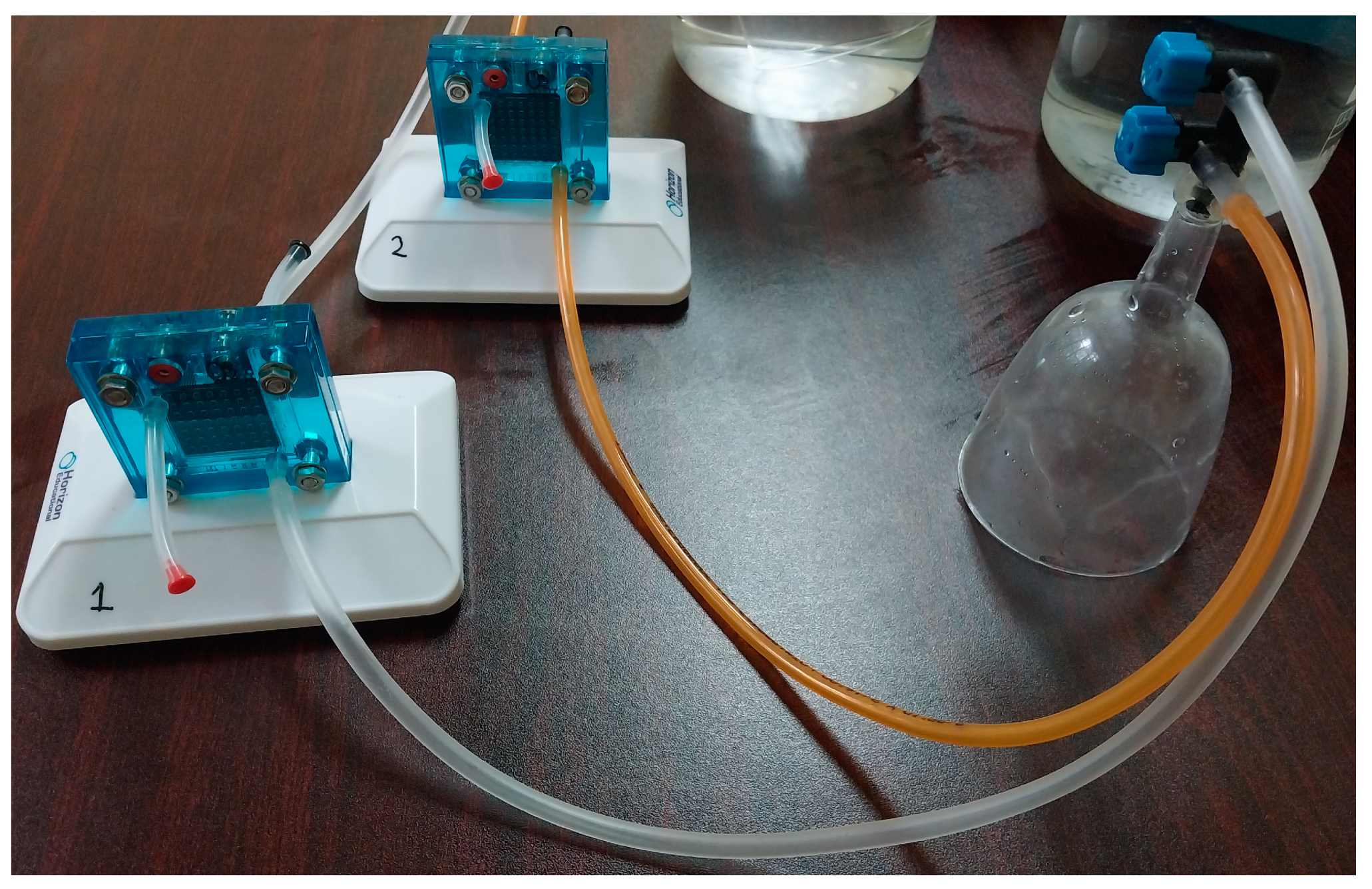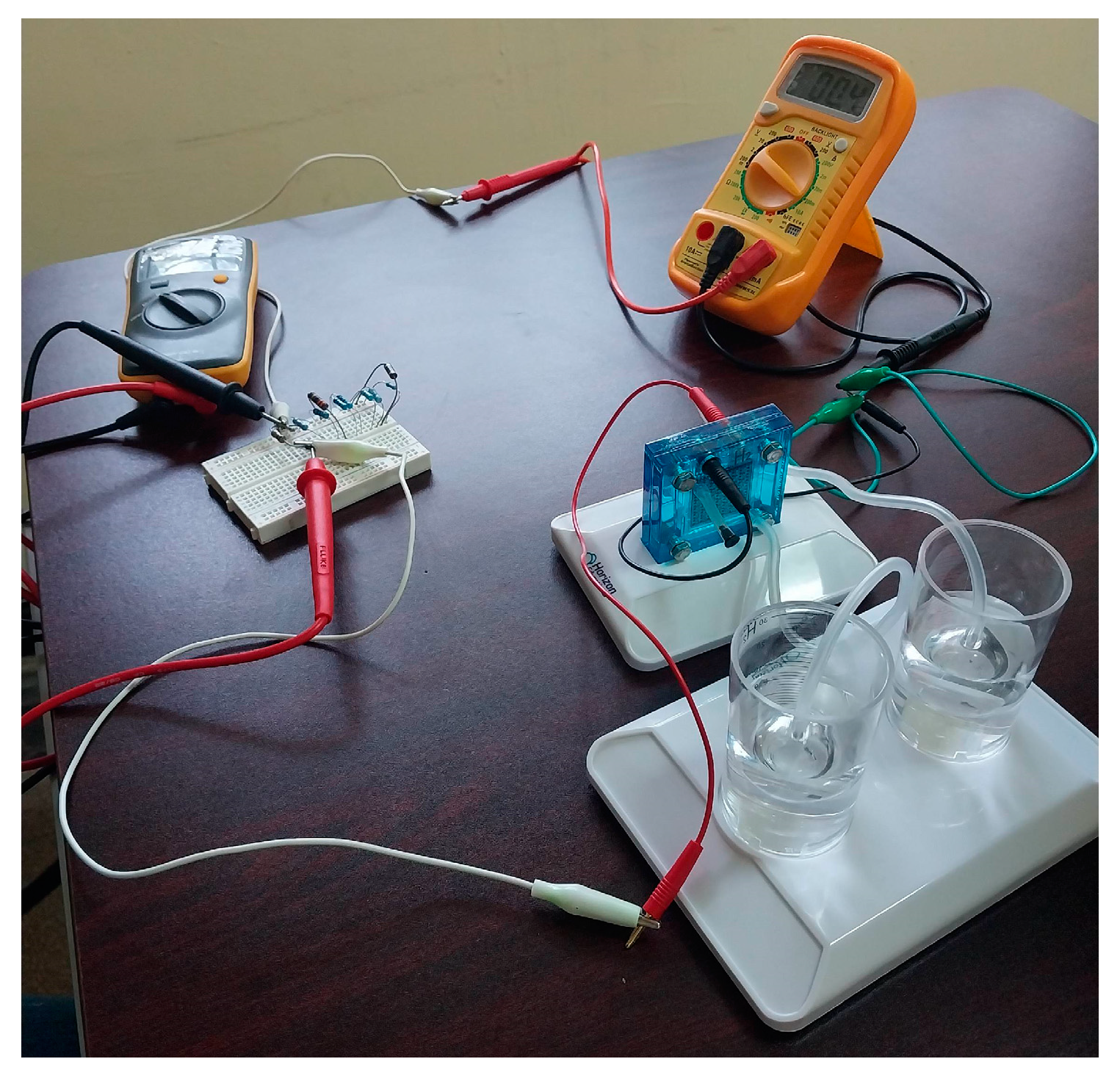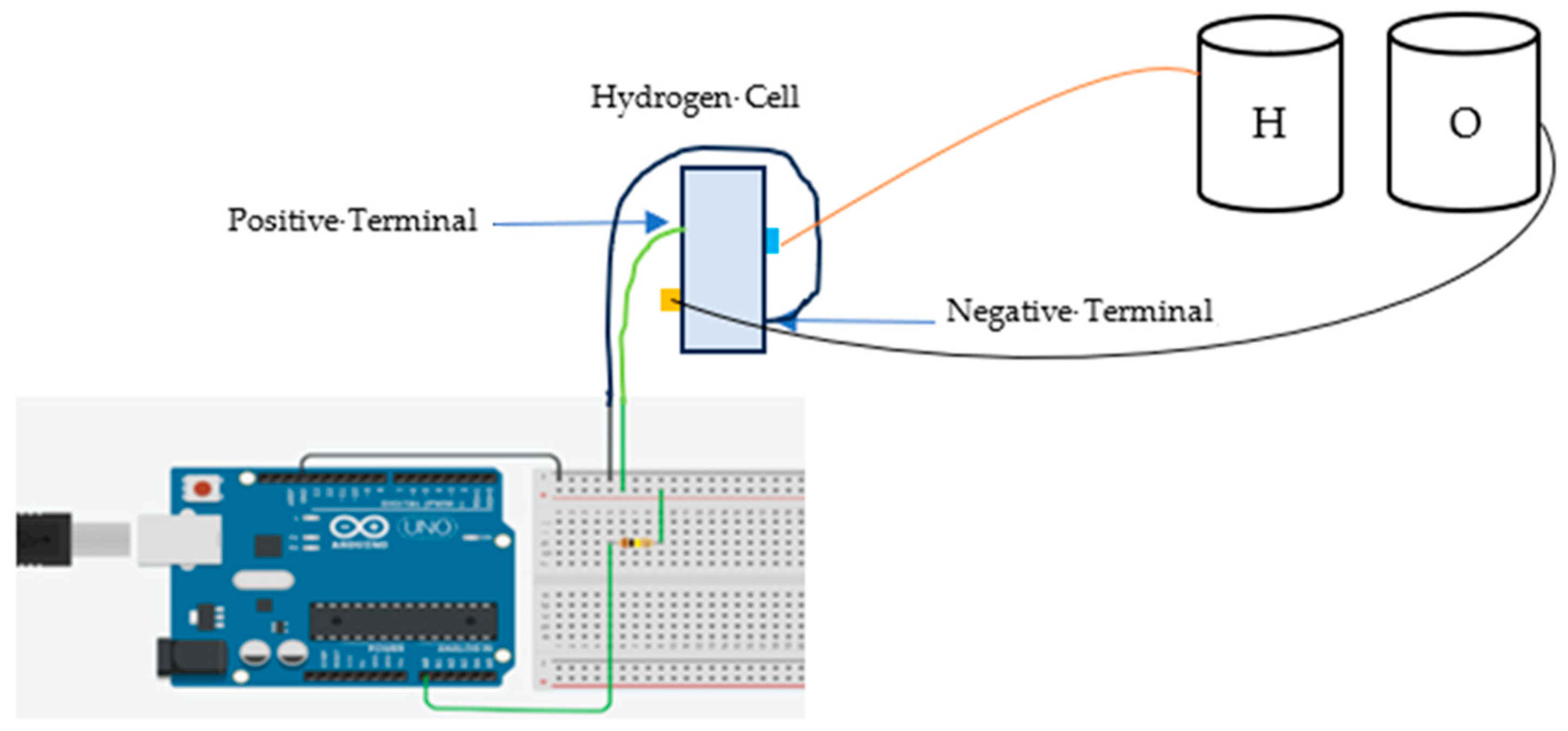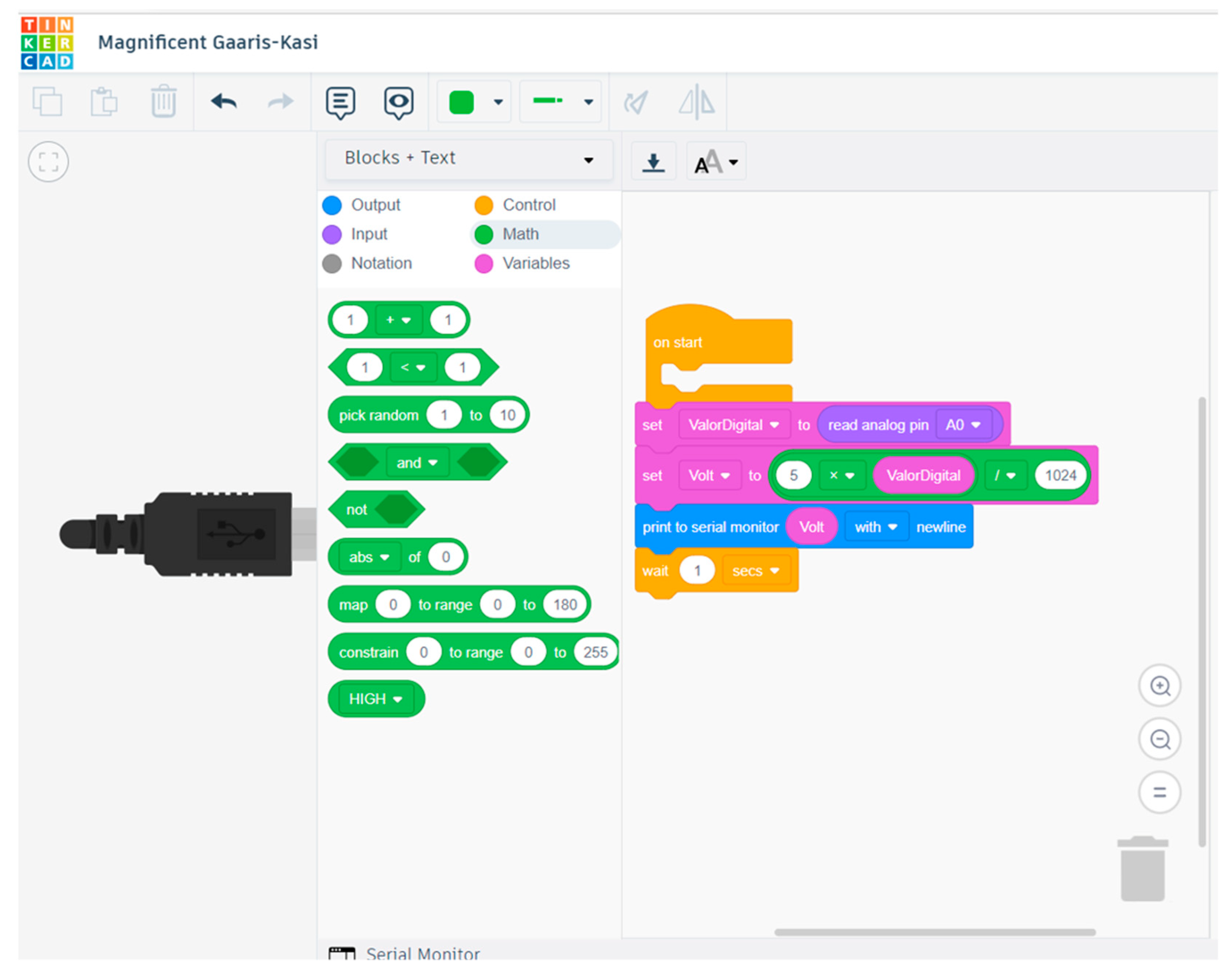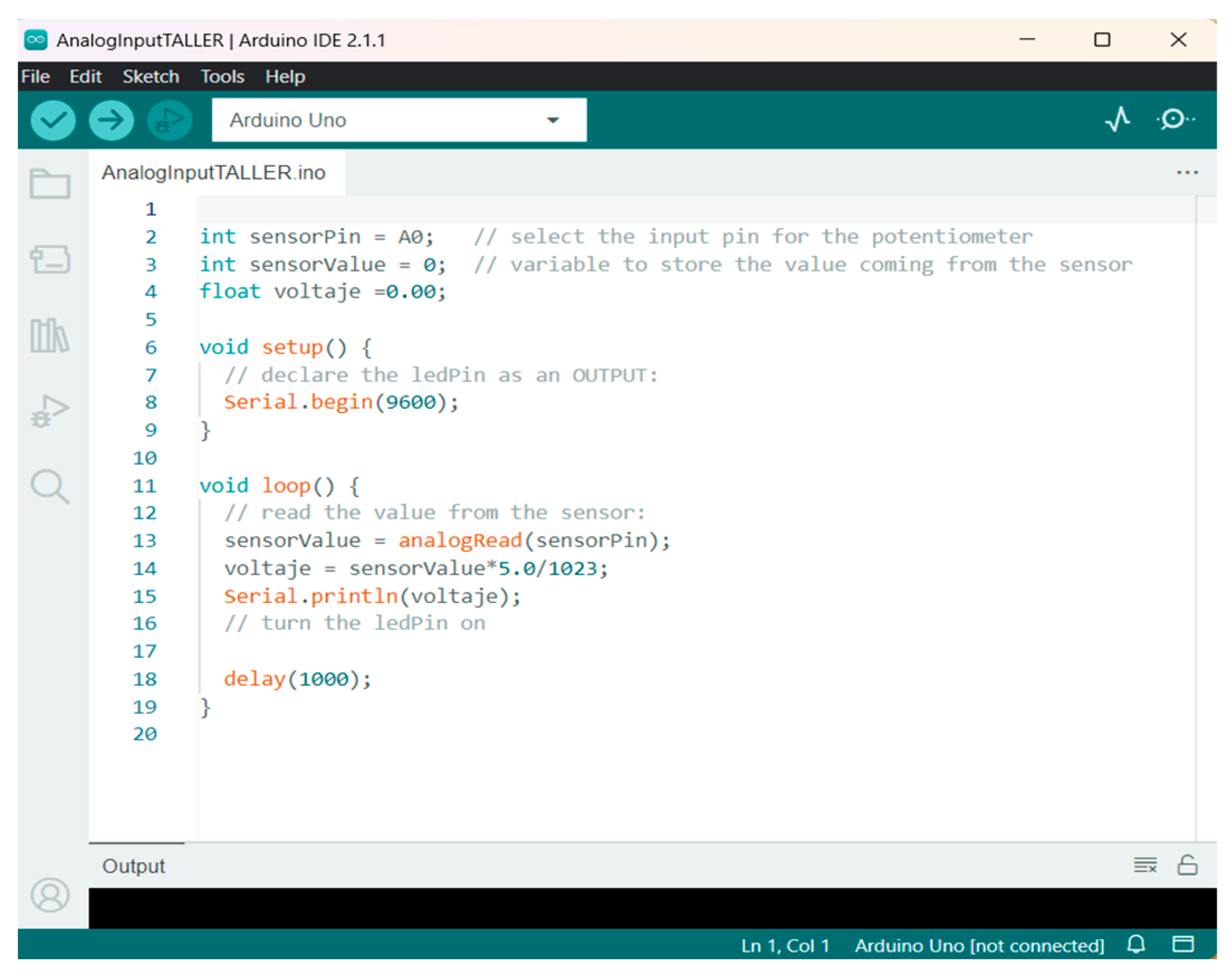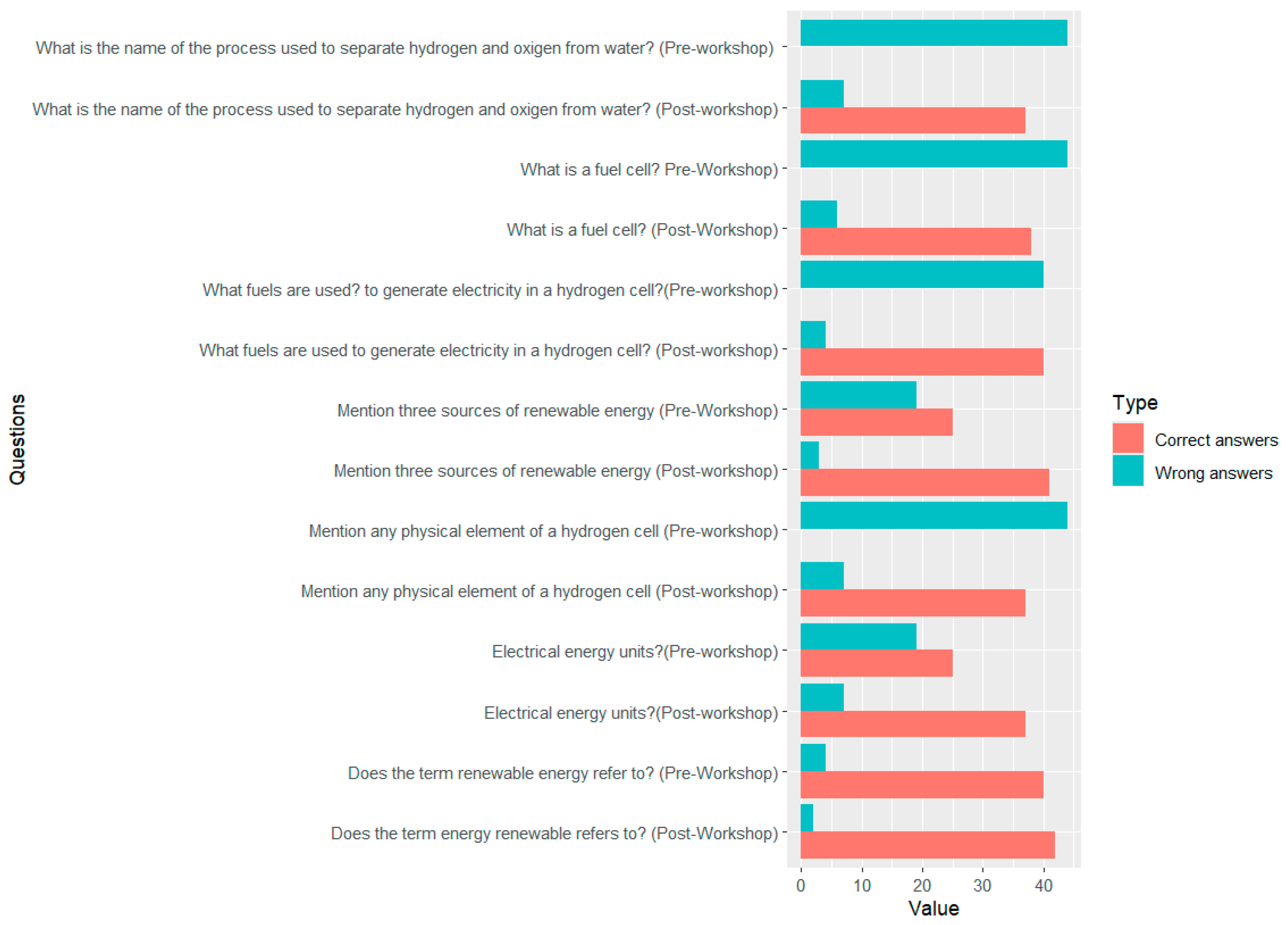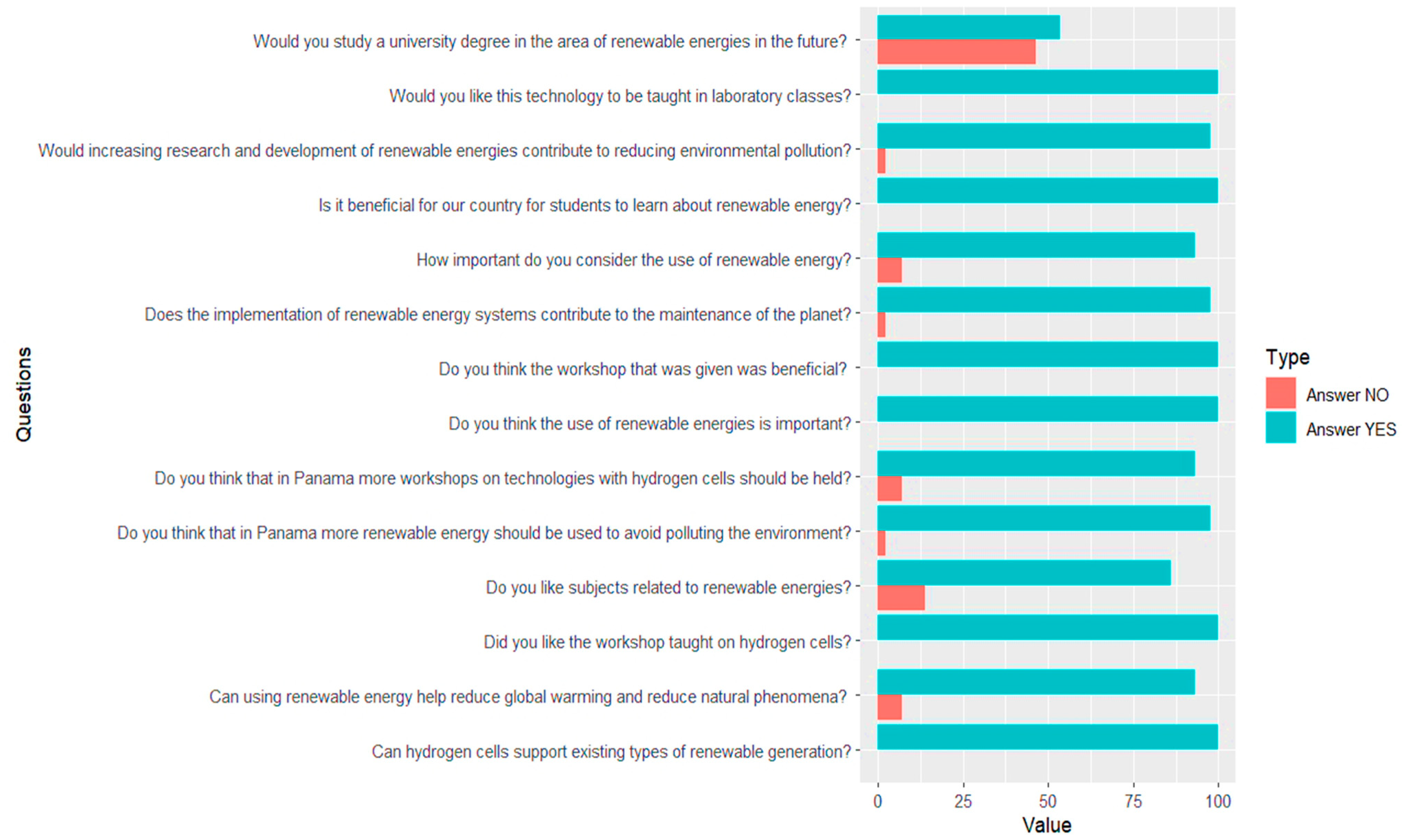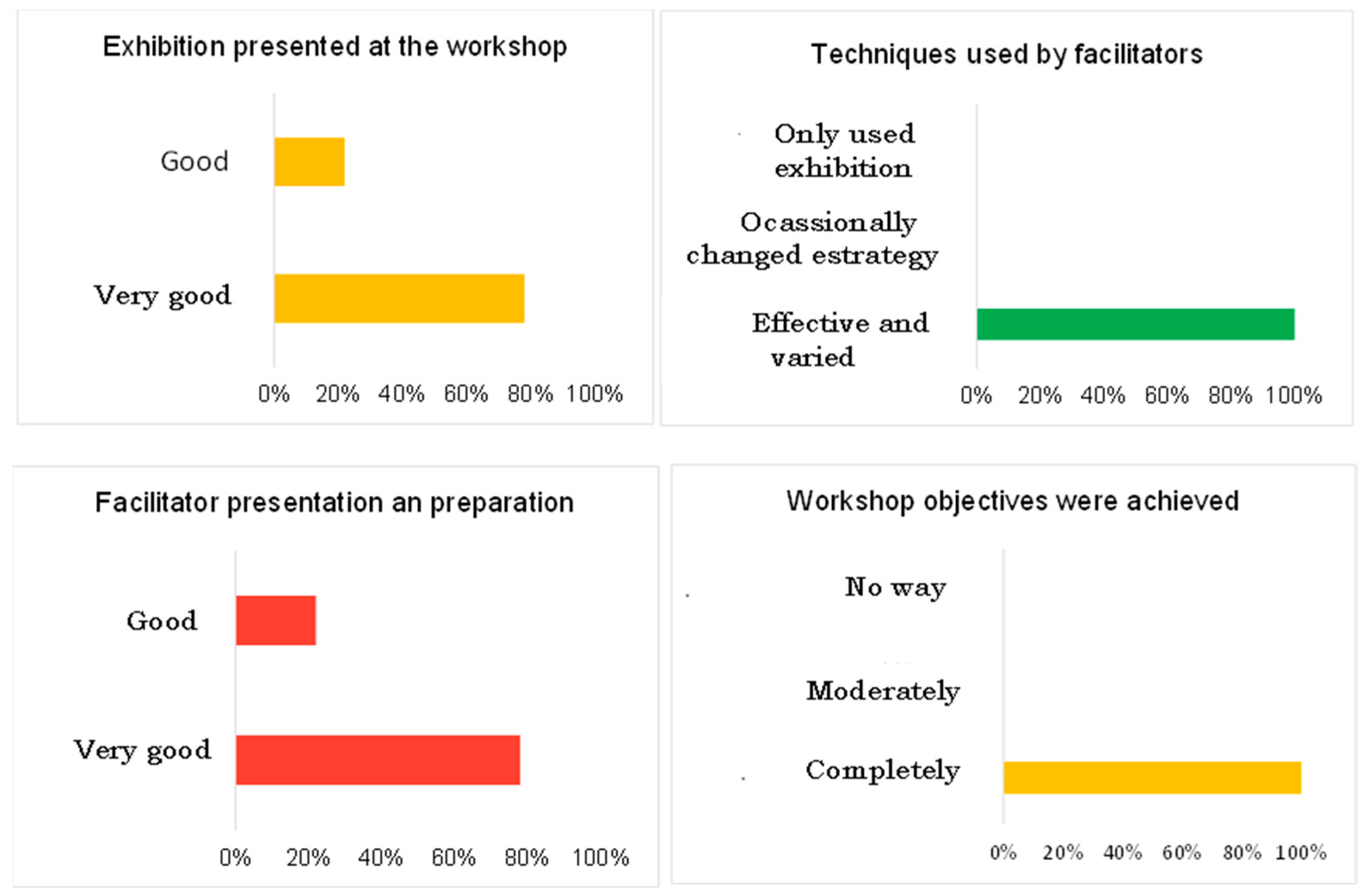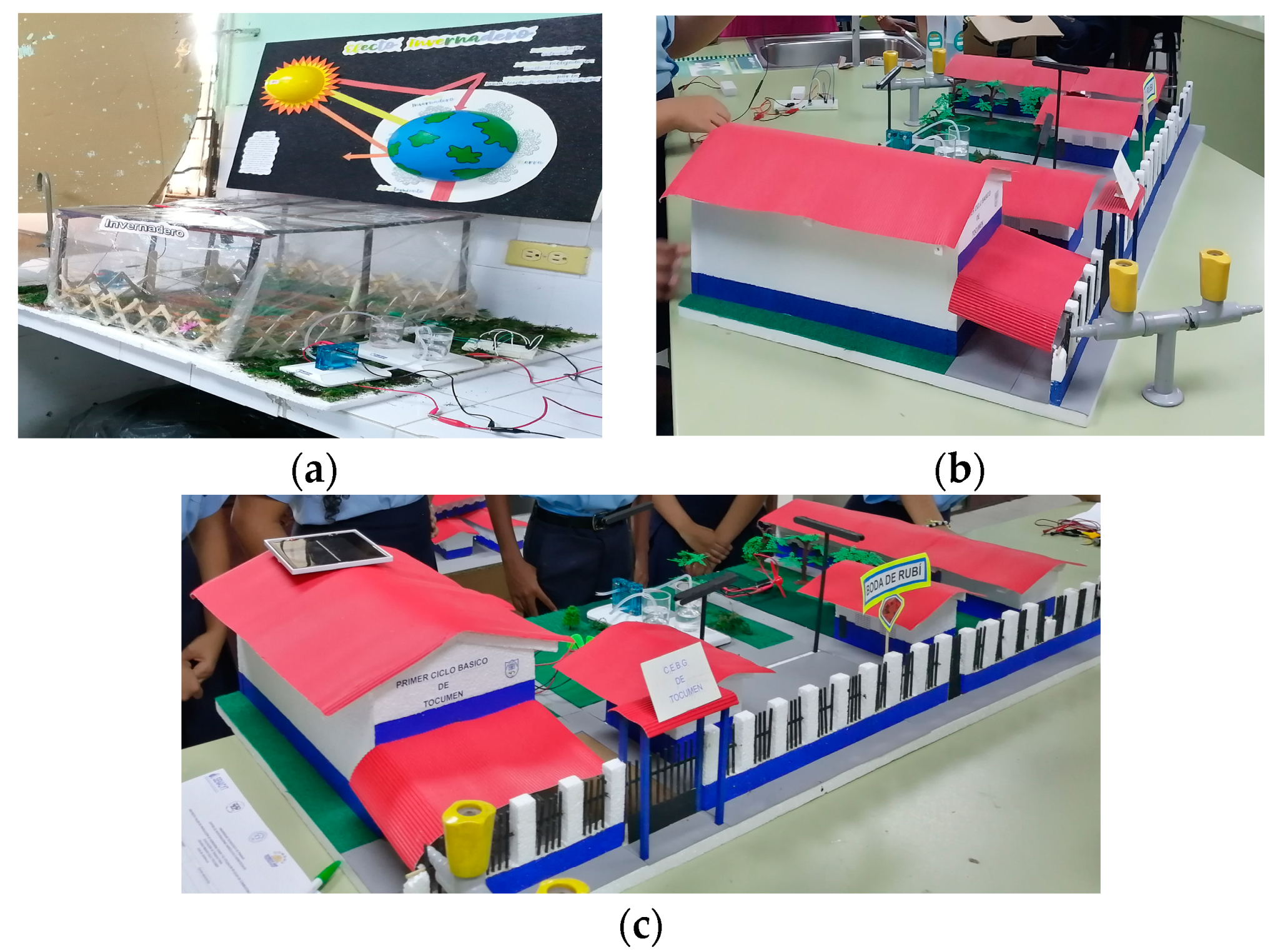1. Introduction
The gradual increase in greenhouse gas emissions resulting from the excessive use of fossil fuels has caused the planet’s average temperature to increase [
1]. Policies have been established worldwide to mitigate this problem [
2,
3].
In this context and with the objective of complying with the aforementioned agreements, Panama presents the challenge of promoting the energy sector towards energy diversity that makes the most of the country’s great potential for renewable energy resources [
4]. However, to increase the energy matrix, research aimed at the study and integration of other renewable energy sources is necessary.
Hydrogen (H
2) is one of the technologies that could be supportive in solving the energy problem [
5], since it is an element considered a clean energy vector that can be produced from any primary energy source; on the other hand, there are fuel cells, which are very efficient energy conversion devices. Fuel cells are electrochemical systems that use hydrogen and oxygen to produce electrical energy and are based on an oxidation-reduction reaction in which hydrogen acts as fuel and circulates through the anode (negative electrode), while an oxidant, generally oxygen or air, is continuously fed into the cathode (positive electrode) [
6]; in these types of proton exchange membrane fuel cells (PEMFCs) that operate with hydrogen and oxygen, water is the only by-product obtained [
7].
Regarding the potential of hydrogen cell technology, the National Secretariat of Energy has launched the green hydrogen roadmap in Panama. This plan will allow Panama to become the global green hydrogen route par excellence for the region, and it will help to face the commitment of decarbonization and energy transition [
8]. Additionally, this technology is expected to continue its evolution and help raise environmental awareness. Because education constitutes a fundamental principle of change, it is necessary to focus on teaching hydrogen cell technology and other types of renewable energy generation in schools. This will increase energy social responsibility and interest in using alternative energies as a strategy to reduce the environmental problems we are experiencing as a society [
9].
In Panama, as in the rest of the world, it is urgent to modify individuals’ values and attitudes in the face of changes that hurt the environment, since environmental education in schools is addressed superficially [
10].
Educational centers are privileged in promoting “environmental values”, which are fundamental. Furthermore, they can incorporate participatory education, self-respect, and identifying and valuing the natural and cultural heritage of the environment.
Efforts have been made in developing environmental projects, such as the proposal developed by Jiménez [
11] for the Monsignor Francisco Beckmann General Basic Education Center, whose objective was to promote environmental education based on a platform aimed at raising awareness in the educational community, on the subject of environmental integration into the official curriculum as a transversal axis; the second objective was the elaboration of a design of the educational project of the Center. On the other hand, Zambrano et al. [
12] developed interactive murals as a teaching method to promote interest and environmental awareness in recycling techniques in high school students of the First Basic Cycle Tocumen in Panama City, managing to strengthen the educational skills and interest of students to improve learning and promote the use of recycling. On the other hand, Martínez et al. [
13] developed a project called Gamified Ecology (ECOGAMI) aimed at the design, development, and implementation of digital and non-digital educational products using the concept of gamification to promote and improve the teaching of environmental education in primary school students. The results indicate this proposal’s positive impact on the teaching–learning process in students. Quiróz et al. [
14] developed an environmental awareness and education plan in communities in the province of Chiriquí, with the aim of raising awareness of the role played by amphibians in ecosystems. With this project, they can teach remote communities about the importance of protecting the fauna of endangered ecosystems. Osorio, 2000 [
15], developed a participatory environmental education project in the community of Viejo Veranillo, the capital district of Panama, to generate new knowledge from the practice of intervention in reality, to offer guidance to future research and other similar experiences of participatory and community education. On the other hand, Almanza, 2000 [
16], aims to raise awareness and sensitize teachers of general primary education through the development of an environmental education program aimed at pre-secondary students (7th, 8th, and 9th grade) of general primary education to contribute to the defense of the environment and to promote solutions to the concrete realities of the country.
It is necessary to focus on promoting the interest of students, not only in the area of the environment but also in the area of renewable energies, so that they are entities that can help mitigate the environmental effects caused by the use of fossil fuels.
Currently, education is experiencing a crisis in which school failures and dropouts prevail, due in large part to our educational system’s obsolete educational model [
17]. This model is deficient, as we are taught to memorize and complete tests to complete a curriculum. However, we must be able to train students who have the capacity for thinking, creativity, and teamwork.
To strengthen and promote students’ interest, it is necessary to use tools and techniques different from those currently used in the school environment. Among these are gamification [
18], project-based learning [
19], and school activities [
20]. Another technique that combines all of the above is educational workshops, which include theory and practice on a specific topic. In this last method, the student acquires knowledge practically through research, teamwork, and self-discovery.
It has been shown that educational workshops have an investigative, pedagogical-didactic, and linguistic-communicative character that indicates their value as a multifunctional, interactive, and systematic strategy to contribute to conventional education and thus awaken students’ interest in a specific topic [
21].
On using educational workshops as a pedagogical tool for teaching renewable energies, Clara Calderón et al. [
22] propose a solar cell workshop to teach middle school students the basic concepts of electricity and the importance of using renewable and non-polluting energy sources to generate electricity. The researchers carried out several activities within the teaching process and evidenced the learning and motivation of the students in the development of their school projects.
Cisterna et al. [
23] worked with workshops and demonstrative models of two solar energy systems, a solar oven and water collector, for food preparation and domestic hot water, which are feasible to build and use at school and at home. This activity allowed the transfer of knowledge and the development of critical thinking in the context of primary school education in Tucumán.
On the other hand, Watkins et al. [
24] work with energy efficiency and solar energy workshops. During these workshops, they perform measurements, calculations, and inferences from experimentally obtained data. They also promote the use of laboratory material in the area of energy technology with practices that respond to demands of educational interest and the active participation of students in the construction of knowledge. The results are very satisfactory, and this is evident in the enthusiasm and participation of the educational community.
Guzmán Fraile et al. [
25] seek to strengthen scientific and mathematical competencies in formulating and solving problems in mathematics and natural sciences. For this development, the interactive technique is used in their workshop, and from the information collected, it is possible to develop a pedagogical proposal called “Interactive and pedagogical laboratory networks of renewable energies”, in which five activities are proposed that involve the educational community of different educational institutions in the department of Vichada. They motivate students and relate the topic of renewable energies to the context of problems of daily life at home and at school.
Roa Piñeros [
26] seeks to teach ninth-grade students at the Guanegro educational institution the availability of renewable energy and its autonomous electricity generation, which allows them to contribute to the care of the environment. As a result of the above, it is concluded that for the majority of students, the term renewable energy is not unknown; they have familiarity with the topic and show interest in the different renewable energy systems (solar, hydraulic, etc.), especially in biomass energy.
Lucchinni et al. [
27] present activities carried out in a secondary school in the province of Córdoba, aiming to disseminate the technological applications of solar energy and promote active and participatory learning for students and teachers. These activities were based on the request for advice from teachers of an educational institution to present work at a science and technology fair. The necessary anchors for constructive learning were generated based on the concepts of the students who had already researched the topic. As a motivating element, we worked on constructing and testing solar dryers (workshop methodology). The prototype met the proposed objectives. The results of the drying tests positively motivated the students to make modifications and new proposals.
Drozinsky, 2022 [
28], developed an “Energy: the Dilemma” workshop. The workshop aims to characterize the different types of energy and identify their benefits and harms to assume a critical stance regarding energy use within the framework of sustainable development goals (SDGs). To this end, it is proposed that the types of energy, their benefits and harms, their influence on global warming, and their articulation with the SDGs be addressed. The way to approach the themes will be through games, analysis of journalistic articles, role-playing, and analysis of audiovisual material. The workshop is part of the subject Biology and is aimed mainly at first-year high school students in Misiones, Argentina.
Delgado et al. [
29] developed a project in the home energy sustainability field considering the SDGs’ specific learning objectives described in the cognitive, socio-emotional, and behavioral domains. The project is based on developing training plans in renewable energy and training in energy management at home, based on a constructivist learning model and developing educational prototypes. They use workshops aimed at students who have learned renewable energy concepts and associated criteria for energy management at home, including sustainability and environmental resistance criteria.
Rolled Nieto [
30] carries out an analysis of the social perception and existing dissemination systems of two of the main applications of hydrogen and fuel cell technologies, such as firstly, the storage of energy from hydrogen and its transformation into electricity through fuel cells applied to stationary systems and, secondly, the use of fuel cells in the transportation sector. The study focused on 3rd and 4th-year education students, and interactive workshops were used in which there was active student participation. The analysis of the results shows the benefits achieved with the development of this type of project.
Ávila et al. [
31] propose under the name PROCOLER (Collaborative Project in Renewable Energy) a teaching project being implemented in some schools in Bogotá and Burgos, at primary and middle school levels (Secondary), with a variable number of participants and action research methodology, with different activities developed on the topic of biomass and the implementation of workshops and presentations on biomass with students (fuel drying, compost for which they prepare teaching materials on the topic above). They have been well received in schools, although there is still some reluctance to integrate these workshops into classroom training.
As has been verified in the literature review, the workshops carried out focus mainly on types of solar, hydraulic, and biomass generation; however, regarding workshops related to hydrogen cell technology at an international level, there needs to be more evidence of related work. In the case of Panama, there is no evidence of the development of workshops that apply this type of technology. Therefore, the project presented here attempts to cover this gap, presenting the development of workshops through management of and experimentation with small-scale fuel cells to quantitatively and qualitatively measure the knowledge and interest acquired by 44 students from the pre-media level of an educational center in Panama City.
With this project, we try to promote the study of this technology in Panama since, due to its geographical position, it constitutes a strategic site with great potential for the production of green hydrogen. On the other hand, its design is adapted so that it can be replicated in various educational centers, nationally and internationally, ensuring its sustainability over time.
The methodology for developing the workshops is presented in the following section, as a first point, followed by
Section 2, in which the results and discussion of the evaluation and motivation surveys are presented. The third section presents our conclusions after analyzing the results; the article framework is given in
Figure 1.
2. Development of Workshops with Hydrogen Cells
The methodology used responds to the intention of achieving the development of educational capabilities and the motivation of 44 high school students. For this, a hydrogen production system is used, consisting of an electrical energy generation kit made up of a fuel cell, electrolyzer, solar panel, LED, light bulbs, multimeters, batteries, and a microcontroller. The educational institution chosen was in the official sector of Panama City: The First Basic Cycle Tocumen.
The instruments for data collection were a pre-workshop questionnaire, a post-workshop questionnaire, an oral evaluation of the presentation of their final projects, and a motivation survey. The pre-and post-workshop surveys are part of the non-experimental design that involves evaluating the participants before and after a specific treatment, in our case, the workshop. The final motivation survey was conducted to measure each student’s level of interest in hydrogen cell technology.
Questionnaires or evaluations involve carrying out two measurements as indicated [
32]: on the one hand, the dependent variable, which in our case would be the measurement of prior and subsequent knowledge; this is followed by the independent variable, which would be the treatment or the workshop. The participants act as self-controls, and the comparisons before and after having completed the workshop are the knowledge.
The initial activities focused on holding coordination meetings with the directors and teachers designated by the schools to request the corresponding permits and the list of students who would participate. During these first visits, the verification of the science or computer laboratories that would be used to carry out the experience and the purchase of the experimental kits were organized and prepared.
Five general stages are defined: 1. pre-evaluation, 2. preparation of manuals, 3. development of workshops (theory and practice), 4. the final project, and 5. post-assessment (questionnaire and surveys) (
Figure 2).
2.1. Pre-Assessment
The first stage of the research is collecting or applying a pre-evaluation test that measures the students’ level of skills or knowledge in mathematics, digital competence, scientific curiosity, and basic sciences, including renewable energy. This first stage constitutes a fundamental part of our research, since it provides quantitative data for evaluating the potential of workshops as a pedagogical strategy.
Each form or pre-assessment included generic data, such as the student’s name, age, sex, name of the school, location, course, and age, to record the study group’s profile. It compiled 14 questions, including 6 closed questions with 2 possibilities (yes and no) and 8 questions where the best answer had to be chosen.
It should be noted that the pre-evaluation served as a basis for the development of the different inductions of the workshop since, with this, a metric of the level of knowledge that the students had at the beginning of the workshop was obtained and a better focus and consolidation in the areas of deficiency found.
Questions were added to the pre-evaluation questionnaire to measure different competencies, as mentioned above, to provide a basis for developing inductions before the tests. It should be noted that due to the focus of this article, only the questionnaire related to knowledge of renewable energies and hydrogen cells was taken into account.
2.2. Preparation of Manuals
The second phase was the construction of procedure manuals made up of a compendium of tests previously prepared in the laboratory that integrated step-by-step procedures both for the assembly of each of the elements of the kit and for the hydrogen production process, the generation of electricity and its application for turning on an LED and fan. In general, the objectives that we tried to achieve with the students were as follows:
Teach the main concepts on which devices called fuel cells are based.
Carry out the assembly of the experimental kit and identify the different elements that make up the electrochemical system, which consists of a solar module, an electrolyzer, and a PEM-type fuel cell.
Produce hydrogen and oxygen using an electrolyzer.
Feed fuel cells with the hydrogen produced and generate electricity.
Determine the operating parameters of the hydrogen cell.
Merge all the theoretical and practical concepts analyzed in the workshop to apply the electrochemical system to power a small-scale load and allow students to observe the system’s performance and behavior in a real application.
In addition to the essays previously mentioned in the objectives, the manual contained theoretical information regarding electronics, hydrogen cells, and renewable energies so that students could strengthen their knowledge and, together with the inductions given, could carry out the practical stage.
The main parts of the manual’s content included a definition of the work objectives, a brief introduction about the manual’s importance, the theoretical basis of circuits, renewable energies, and hydrogen, and finally, the different proposed tests, see
Figure 3 and
Table 1.
The manual introduced information on using open-source Thinkercad software V1.0.0.0 [
33], which served as a tool for carrying out circuit simulations during the last stage, which constituted preparing a final project in which they could use the knowledge previously acquired.
2.3. Development of Workshops (Theory and Practice)
The third stage contains four phases: the induction phase, the assembly and validation phase of the kit, the cell application phase on a breadboard, and finally, the learning phase of a program for the simulation of electronic circuits (
Figure 4).
2.3.1. Theoretical or Induction Phase
The theoretical or induction phase is designed to obtain a program of pedagogical activities so that students understand the general theoretical concepts related to hydrogen cell technology, the elements that compose it, fuel cells, electronics, renewable energies, electrical circuits, and the assembly of the kit for the production and generation of electrical energy. Within this phase, an induction is given on different safety aspects that must be considered when using the hydrogen production kits. In all inductions, students could ask questions and clarify their doubts regarding the topic presented.
For the student’s learning to be motivating, dynamic, and meaningful, the development of the inductions included activities such as conferences, videos, readings, and interaction of the students with the hydrogen production kit so that they could learn the different elements that make up these electrochemical systems.
During the experimental or practical phase, each participant received procedure manuals as a theoretical and practical guide to the different tests proposed in the workshop. Following the delivery of these documents, the students prepared and assembled a kit that included a hydrogen cell, an electrolyzer, a solar panel, and a lighting source and applied this system to supply electrical energy to a small-scale load using breadboards (breadboard, LED’s, resistors, and switches). In this phase, the researchers and teachers were present to help the students assemble and carry out the tests outlined in the procedure manual.
The workshops ended with an induction stage on the use of the open-source software Thinkercad. Thinkercad is nothing more than an electronic circuit simulator accessed through the web and supports microcontrollers such as Arduino Uno [
31], Micro: bit boards [
34], and ATtiny chips [
35].
The objective of familiarizing the students with this mentioned application was so that it could serve as a tool to carry out simulations of electronic circuits and adapt LEDs and electronic components to the projects that they would develop at the end of the workshops, in which they would use hydrogen cells and fuel generation in a residential model or small-scale application.
2.3.2. Experimental Phase
In this experimental stage, students had the opportunity to interact directly with the elements that make up the hydrogen cells and the assembly of the different elements to produce electrical energy. Before starting this stage, a survey of knowledge related to renewable energies and hydrogen cells was carried out so that the researchers could adapt concepts and experiments according to the student’s previous knowledge. The experimental session was developed by using several experiments, among which it is worth highlighting the following.
Objectives: This experience aimed to teach students the assembly and identification of the elements that make up hydrogen cells.
Project: Students identify the different elements and connect plastic pipes on the anode and cathode sides of the cell of their experiment. They moisten the proton exchange membrane using distilled water and a syringe. They then place the hydrogen and oxygen container cylinders on a plastic base so that they are firmly attached.
They connect the hydrogen (H
2) and oxygen (O
2) container cylinders to their respective connections in the cell on the anode and cathode sides. Next, they connect the cables of the photovoltaic solar panel or battery pack to the electrical inputs of the fuel cell (reversible) for the electrolysis process (
Figure 5,
Figure 6,
Figure 7 and
Figure 8).
- 2.
Experiment with an electric motor powered by a fuel cell
Objectives: The objective of this experience is to teach students the connection between an external load (electric motor) and the use of the energy stored in the form of hydrogen in the containers of the previous experiment.
Project: The students had to produce hydrogen using the production kit and distilled water provided by the project researchers, then assemble a small electric motor, generate electrical energy with the cell, and run the motor, which was achieved by integrating some blades. The students had to record the operating time of the engine before the hydrogen in the container ran out. At the end of the experiment, students wrote down their observations and difficulties.
In addition to powering the engine with the hydrogen kit, the students had the opportunity to use a solar panel to power the engine itself and verify its operation, see
Figure 9 and
Figure 10.
- 3.
Experiment with the connection of two fuel cells in a series
Objectives: Increase the amount of hydrogen produced and store it in a larger capacity container.
Project: For this experiment, the students had to connect a regulator and pipes to a plunger and tank with a greater storage capacity and use two cells to generate hydrogen. When obtaining hydrogen, the students had to take the time taken for hydrogen to autonomously cope with the load and compare it with the previous experiment, using smaller containers (
Figure 11 and
Figure 12).
- 4.
Fuel cell characteristic curve
Objectives: Characterize the fuel cell in static operation.
Project: For this experiment, the students used a Protoboard and resistors, which varied between 1000, 500, 200, 100, 75, 50, 25, and 5 ohms (
Figure 13).
They placed the resistors on the breadboard and then made current and voltage measurements, connecting the cell between the two terminals of each resistor, as shown in
Figure 13 and
Figure 14. The students had to make notes of the magnitudes obtained for each resistance and graph the data obtained to obtain the cell’s static operating characteristic curve (polarization curve).
- 5.
Cell voltage monitoring experiment with Arduino
Objectives: Use the Thinkercad V.1.0.0.0 and Arduino V 2.1.1 programs to obtain real-time voltage data at the hydrogen cells’ terminals.
The aim was for students to learn about using both tools and their application in hydrogen cells to measure variables involved in generating electrical energy.
Project: The students had to generate hydrogen, store it in the containers, and then develop a program using the Thinkercad tool to generate a voltage and voltage monitoring program at the cell terminals.
After creating the program in Thinkercad, the students had to integrate it into the Arduino IDE program and perform a run to verify the values of the variables under study (voltage and current) through the Arduino IDE user panel, allowing them to obtain the data, on the screen, of the variables studied.
The students acquired the data generated by the Arduino and transferred it into an Excel V. 2016 spreadsheet. They then graphed the cell’s characteristic curve, called the polarization curve, shown in
Figure 15,
Figure 16,
Figure 17 and
Figure 18.
2.4. Final Project
With the completion of the third stage, the fourth stage began, which was aimed at students using the acquired knowledge, both practical and theoretical; with the guidance of professors and researchers and with the green hydrogen production kit, they developed their technology application project. The latter was presented through a model and an oral presentation. At this stage, students had to use the Thinkercad software V1.0.0.0 and the microcontroller to design a circuit that would power their system with LEDs, resistors, and hydrogen cells. In addition to the LEDs, they were given a kit that included switches, connection cables, connectors, fans, nose clips, and cutting clips to facilitate the development of their projects.
2.5. Post-Assessment
The fifth and final stage was the application of a final evaluation identical to the pre-evaluation, whose main objective was to compare the results before and after the workshop and infer whether they affected the advancement of knowledge of the sample of students analyzed.
In addition to the evaluation survey, a motivation survey was applied. The questions presented relate to the student’s interest in the use and study of this type of energy generation and the importance, according to their perspective, of teaching this topic in their classrooms.
On the other hand, an interview was carried out in which the students expressed their opinion regarding the benefit of the workshop and their motivation regarding the study of non-conventional forms of electrical energy generation.
3. Results and Discussion
In this section, we present the results achieved with the fulfillment of each of the objectives from the perspective of the student’s learning and how motivated they were in topics related to renewable energies and hydrogen cell technology at the end of the course workshop.
3.1. Evaluation of Pre- and Post-Workshop Tests
The percentage graphs helped us evaluate the impact of the workshops on improving knowledge of aspects related to renewable energies and hydrogen cells. In this sense, if we look at the graph in
Figure 19, there is a significant increase in the percentages of correct answers at the end of the workshop compared to the percentages observed at the beginning. Regarding the percentages obtained in the initial surveys for the questions corresponding to the topic of hydrogen cells, we can note that the percentages are 0%, as there is no prior knowledge of this technology, which contrast with the percentages obtained after the workshop, which occupy between 84.1% and 90.9% for correct answers. In the questions on aspects of renewable energy, the percentage of correct answers for the question on the meaning of renewable energy occupies a high percentage of 90.9% correct answers at the beginning of the workshop compared to 9.1% incorrect answers, obtaining at the end of the workshops a percentage decrease in incorrect answers of 4.5%. The correct percentage increased by 4.6%.
For the questions related to knowledge of types or sources of renewable energy, the percentage of correct answers was 56.8% and incorrect answers was 43.2%; their answers improved at the end of the workshop, with a percentage of correct answers of 93.2%, and the percentage of incorrect answers decreased to a value of 6.8%.
The increasing trend in the percentages after the workshop demonstrates, more markedly than the percentages of correct answers related to renewable energies, the deficiency of students’ knowledge about hydrogen cells, as it is an emerging technology that has yet to be introduced in the classroom. The final results reflect an increase in the percentages for knowledge about hydrogen cells, which shows that the students acquired knowledge about the use of and elements that constitute hydrogen cells.
3.2. Evaluation of the Motivation Survey
The application of the motivation survey provided us with information regarding the interest that students showed both in the topic of hydrogen cells and in the use of renewable energies and their implementation in schools. From the graphs in
Figure 20, we obtained percentages between 97.7% and 100% in the queries related to the importance of renewable energies and, additionally, their implementation in Panama, where this type of workshop is taught in classrooms.
The percentage differences were almost similar, 46.5% and 53.5%, in the query related to the student’s interest in studying this topic of renewable energy at the university level. On the other hand, 100% acceptance was recorded regarding the support that hydrogen cells can give to existing renewable technologies, and 86% positive acceptance of the workshop was given. These percentages denote students’ motivation in the study and application of renewable energies and hydrogen cells.
3.3. Results of Workshop Perception Surveys
We conducted another survey to evaluate our strengths and possible areas for improvement as researchers, with the goal of developing future activities with high school students from public schools.
The results of the surveys above,
Figure 21, show a high percentage of acceptance in the aspect related to satisfaction with the workshops, specifically the topics presented in the workshop, with the percentage of “good presentation” at 80% and 20% of those surveyed responding “good” regarding the techniques used for the workshops; we obtained a 100% opinion of their effectiveness and variation of techniques. Regarding the presentation and preparation of the facilitators, we obtained 20% “good” and 80% “very good”, and a total of 100% thought that the workshop objectives were met. The perception survey results denote that the project researchers met the workshop’s objectives, and their exhibition techniques and digital technologies favored the explanations of each of the concepts and procedures necessary to carry out the workshop.
3.4. Practical Results
With the completion of the workshop stage, the final project construction stage began. This stage explicitly aims at students using the acquired practical and theoretical knowledge to create a model that integrates the kit by producing hydrogen and electronic elements, with the possibility of making improvements and integrating new elements according to their imagination and design (
Figure 22).
According to the evaluations carried out on each of the projects, students managed to integrate hydrogen cells into their designs to power the different electrical charges used in their designs.
Among the contest winners, there was a first-place winning design with a model alluding to a greenhouse, in which the student used the energy produced by two hydrogen cells to heat a small-scale cultivation system. The winning students of the other two models used the energy produced by the hydrogen cells to heat the classrooms, using fans and LEDs for lighting in the two schools. The students successfully fulfilled each competency evaluated with the rubric previously prepared to evaluate creativity, project presentation, knowledge, and constructive ability.
In a short interview during the project delivery, both teachers and students positively valued the workshops and commented that the experience had increased the students’ awareness and that they had found the workshop very useful for learning and promoting electricity generation technology using hydrogen cells.
Within the limitations of this study, we could not work with a larger sample of students due to the lack of students due to internal problems of one of the educational centers we chose for the study. Despite this, we obtained data showing improvements in knowledge and motivation in the sample studied.
4. Conclusions
It was proven that the pedagogical technique of workshops constitutes an important tool for promoting and awakening interest in high school students in the study of new forms of alternative energies using small-scale hydrogen cells, as evidenced by the students’ acceptance percentages.
The students’ presentations of the final projects, including the design, construction, and integration of the hydrogen cells, were a clear example of the learning each of them achieved, which will drive and motivate them to continue investigating aspects related to renewable energies.
On the other hand, the theoretical knowledge acquired related to renewable energies, hydrogen cells, the scientific method, and electronics was evidenced through questionnaires and project presentations. These will serve as a basis for continuing to advance in issues related to new forms of renewable energies and in their scientific knowledge.
In the analysis of the evaluations above, pre- and post-workshop, there is evidence of an increase in the percentages of correct answers at the end of the workshops. This shows us the effectiveness of the methodology used to advance students toward their learning objectives.
The students’ knowledge of hydrogen cell technology at the beginning of the workshops was nil, so we detected the importance of teaching this type of technology to diversify the knowledge matrix in terms of unconventional forms of electricity generation.
Workshops in schools can be very helpful in diversifying existing learning techniques, not only for the topic of renewable energies but in diverse areas, since they constitute learning based on the interaction of students with relevant theories and the system under study.
